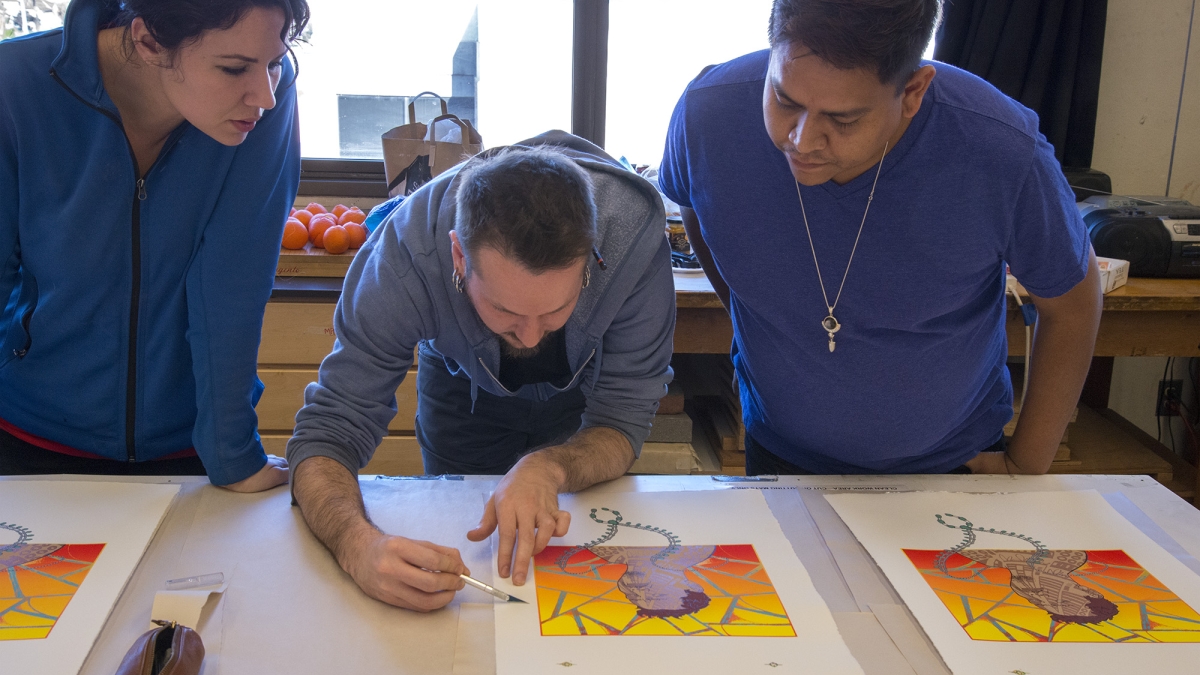ASU Herberger Institute wins 3 highly competitive grants from National Endowment for the Arts

Kate Horvat, Mac Bydalek and Craig Kelly work on a print for Map(ing) 2015. Associate professor Mary Hood recently received a grant from the NEA to help support the biennial printmaking residency program. Photo by Craig Smith.
The National Endowment for the Arts (NEA) has recognized ASU’s Herberger Institute for Design and the Arts with grants for three separate projects totaling $50,000.
In May, the NEA announced its second round of recipients to receive grants this fiscal year, and that list included associate professor Mary Hood in the School of Art and postdoctoral scholar Alexandre Frenette. During its first round of grants, the NEA selected the Herberger Institute’s ASU Art Museum as one of 56 museums nationwide to receive a grant.
“Securing a grant from the NEA is the gold standard of recognition that your ideas have national merit,” said Steven J. Tepper, dean of the Herberger Institute. “To get three awards in a single year is testimony to the fact that ASU and the Herberger Institute are advancing research and creative projects that are models for the rest of the country.”
Associate professor Mary Hood received a $15,000 Art Works grant to help support her Map(ing) project, a biennial printmaking residency program that explores contemporary Native American and Indigenous artistic practices. Art Works grants, the NEA’s main grant category, are awarded to projects that result in creation of art, public engagement with art, lifelong learning in the arts or the strengthening of communities through the arts, according to the NEA.
For Map(ing), Native American and Indigenous artists with very limited or no printmaking experience collaborate with graduate students from the printmaking program at the ASU School of Art to create a limited edition of 25 prints. The teams use printmaking and visual storytelling to explore concepts of culture, place, language and identity. The event concludes with an exhibition and a moderated public forum.
“In the past years I’ve really scraped together the money that’s needed to put together a project like this, with help from the Herberger Institute and the School of Art, who have both funded it over years, and from a lot of community donations,” Hood said. “So the financial support is really important. But the validation of the project is also important. For a granting institution of that size to see the impact of this project is extremely rewarding.”
The Art Works grant program also funds research that investigates the impact of the arts on individuals and groups. In this category, the NEA awarded $15,000 to help fund a study on the careers of arts graduates. Postdoctoral scholar Alexandre Frenette will partner with Timothy J. Dowd from Emory University as co-principal investigators for the project. Using data from the Strategic National Arts Alumni Project (SNAAP), a national survey that documents the experiences of arts alumni, they will look at the factors that shape which graduates remain active in arts-related careers and which ones exit. Dean Tepper, who is the research director for SNAAP, will also serve as principal investigator on the project.
“There are many misleading articles and narratives out there about the careers and lives of people who study the arts,” Frenette said. “There are problems within our educational system and there is inequality, but we’ll really only understand and address these if we pay attention to real facts and data. We will use SNAAP data to better understand the careers of arts graduates and, in the process, show what’s working and what we really do need to improve.”
Frenette’s project is one of only 18 projects nationwide to receive a Research: Art Works grant from the NEA this year.
“I was surprised and very pleased,” Frenette said of receiving the grant. “We were going to pursue this work anyway, but now we can do it much more in-depth. Ultimately, then, the work will have more of an impact.”
In December, the NEA awarded $20,000 to the ASU Art Museum to support an upcoming project called Space in Between. Artist Margarita Cabrera will collaborate with the museum, the Desert Botanical Garden and the Phoenix Latino community to develop a series of soft sculptures in the form of desert plants. The project aims to address themes of art and community, craft, immigration, empowerment, cultural identity and labor practices relevant to the Arizona region and its local immigrant history.
“Margarita Cabrera’s work expands the notion of what community-based art can accomplish by addressing social justice issues in relation to immigration, labor and identity,” said ASU Art Museum curator Julio Cesar Morales.
The sculptures will be on display at the Desert Botanical Garden in the fall of 2016.
For more information on NEA grants and a complete list of recipients, visit arts.gov.
More Arts, humanities and education

Local traffic boxes get a colorful makeover
A team of Arizona State University students recently helped transform bland, beige traffic boxes in Chandler into colorful works…

2 ASU professors, alumnus named 2025 Guggenheim Fellows
Two Arizona State University professors and a university alumnus have been named 2025 Guggenheim Fellows.Regents Professor Sir…

No argument: ASU-led project improves high school students' writing skills
Students in the freshman English class at Phoenix Trevor G. Browne High School often pop the question to teacher Rocio Rivas.No,…

